Courtesy : extension.uga.edu
What Is Compost?
Composting is the natural process of decomposition and recycling of organic material into a humus rich soil amendment known as compost. For any business or institution producing food waste, this organic material can be easily decomposed into high quality compost.
What Can Be Composted?
Fruits, vegetables, dairy products, grains, bread, unbleached paper napkins, coffee filters, eggshells, meats and newspaper can be composted. If it can be eaten or grown in a field or garden, it can be composted. Items that cannot be composted include plastics, grease, glass, and metals — including plastic utensils, condiment packages, plastic wrap, plastic bags, foil, silverware, drinking straws, bottles, polystyrene or chemicals. Items such as red meat, bones and small amounts of paper are acceptable, but they take longer to decompose. Add red meat and bones to only a well-controlled compost pile to avoid attracting vermin, pests and insects to partially decomposed meat scraps.
Food Waste Is Unique as a Compost Agent
Food waste has unique properties as a raw compost agent. Because it has a high moisture content and low physical structure, it is important to mix fresh food waste with a bulking agent that will absorb some of the excess moisture as well as add structure to the mix. Bulking agents with a high C:N ratio, such as sawdust and yard waste, are good choices. Food waste is highly susceptible to odor production — mainly ammonia — and large quantities of leachate. The best prevention for odor is a well-aerated pile that remains aerobic and free of standing water. Leachate can be reduced through aeration and sufficient amounts of a high carbon bulking agent. It is normal to have some odor and leachate production. Captured leachate can be reapplied to the compost.
Pre-Consumer vs. Post-Consumer Food Waste
Pre-consumer food waste is the easiest to compost. It is simply the preparatory food refuse and diminished quality bulk, raw material food that is never seen by the consumer. This food waste is generally already separated from the rest of the waste stream generated, thus no change is needed to keep contaminants out of the future compost. Post-consumer food waste is more challenging because of separation issues. It is simply the table scrap food refuse. Often, after the consumer is done with the food, the waste is subject to contaminants and a decision has to be made on how to separate food from other waste. This can be done by having an extra trashcan that is only used for food waste. Either the kitchen staff or the consumer can separate it depending on the feasibility, flexibility, volume, labor, atmosphere, and attitude of the business or institution. For some operations it may be incorporated as an educational tool or method of demonstrating the company?s proactive environmental policy.
Why Compost Food Waste?
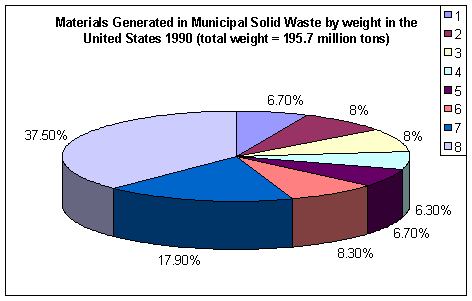
(Scroll right for more)
| Glass | 13.2 million tons |
| Metals | 16.2 million tons |
| Plastics | 16.2 million tons |
| Wood | 12.3 million tons |
| Food | 13.2 million tons |
| Other | 16.3 million tons |
| Yard Trimmings | 35.0 million tons |
| Paper and Paperboard | 73.3 million tons |
| Source: EPA – Summary of Markets for Compost |
Food waste that is not composted generally goes directly to a landfill. To date, 51 percent of Georgia?s landfills are in closure or will be closed within 5 years, and 62 percent will be closed in fewer than 10 years. On average, Georgia landfill tipping fees are between $30 and $40 per ton. As landfills fill up and close at an alarming rate, waste disposal and tipping fees to the businesses and institutions generating the waste will continue to climb. Once in the landfill, organic matter may react with other materials and create toxic leachate. Food waste placed in an airtight landfill stops the earth?s natural cycle of decomposition. This cycle plays a crucial role in the health of our environment. More than 13 million tons of food scraps were generated in 1990, accounting for 9 percent of the Municipal Solid Waste stream in the United States. This percentage can be much higher for tourist intensive areas. More than 72 percent of all materials entering landfills can be diverted through composting. Composting provides a way in which solid wastes, water quality, and agricultural concerns can be joined. An increasing number of communities, businesses, institutions, and individuals are expected to turn to composting to divert materials from landfills and to lower waste management costs. Although waste stream managers view composting primarily as a means to divert materials from disposal facilities, the environmental benefits, including reduction in water pollution, and the economic benefits to farmers, gardeners, and landscapers can be substantial.
Benefits of Compost to the Environment and Agriculture
Environment
- Water and soil conservation.
- Protects groundwater quality.
- Minimizes odors from agricultural areas.
- Avoids methane production and leachate formation in landfills by diverting organics from landfills into compost.
- Prevents erosion and turf loss on roadsides, hillsides, playing fields and golf courses.
- Drastically reduces the need for pesticides and fertilizers.
- Binds heavy metals and prevents them from migrating to water resources, being absorbed by plants, or being bioavailable to humans.
- Off-farm materials can be brought in and added to manure to make compost.
- Facilitates reforestation, wetlands restoration, and wildlife habitat revitalization efforts by amending contaminated, compacted and marginal soils.
- Off-farm materials can be brought in and added to manure to make compost.
- Composted manure weights about one-fourth as much as raw manure per ton.
Agriculture
- Long-term stable organic matter source.
- Buffers soil pH levels.
- Adds organic matter, humus and cation exchange capacity to regenerate poor soils.
- Suppresses certain plant diseases and parasites and kills weed seeds.
- Increases yield and size in some crops.
- Increases length and concentration of roots in some crops.
- Increases soil nutrient content and water holding capacity of sandy soils and water infiltration of clay soils.
- Reduces fertilizer requirements.
- Restores soil structure after natural soil microorganisms have been reduced by the use of chemical fertilizers; compost is a soil innoculant.
- Increases earthworm populations in soil.
- Provides slow, gradual release of nutrients, reducing loss from contaminated soils.
- Reduces water requirements and irrigation.
- Provides pportunity for extra income; high quality compost can be sold at a premium price in established markets.
- Moves manure to non-traditional markets that do not exist for raw manture.
- Brings higher prices for organically grown crops.
- Minimizes odors from agricultural areas.
Source: EPA: Compost – New Applications for an Age-Old Technology
What Are the Benefits to the Food Industry?
- Reduces solid waste disposal fees.
- Ends wasting large quantities of recyclable raw ingredients.
- Educates consumers on the benefits of food waste composting.
- Markets your establishment as environmentally conscious.
- Markets your establishment as one that assists local farmers and the community.
- Helps close the food waste loop by returning it back to agriculture.
- Reduces the need for more landfill space.
How Do I Participate in a Food Waste Compost Program?
Food service businesses and institutions have several options depending on feasibility and specific restraints. If land is available, you may compost the food waste on-site in rows or bins. If minimal space is available or if appearance, odor, and leachate containment is an issue, in-vessel systems or aerated containers are other options that require little attention and labor. Finished compost may be sold for added income or used internally on grounds to beautify landscapes or reduce landscape and soil amendment costs. Finally, the best option may be to export the food waste either to a central compost facility or to a local farmer. Farmers can start food waste composting by using their own kitchen scraps. On a larger scale, farmers can receive free compost feed stock by setting up a system of picking it up from businesses and institutions or having them deliver it to the farm site. Some operations may pay the farmer to pick it up or drop it off for disposal of their waste. Farmers can adapt to the scale that best fits their agricultural system. Larger inputs of food waste may be composted and sold off farm. Agricultural systems may include manures, crop residues, and other organic farm waste as feedstock to the compost if desired.
Who Takes Food Waste for Composting and Who Can I Contact?
- Local farmers may be interested in taking food waste for compost.
- Home gardeners may have the capability to take certain quantities of food waste for compost.
- Local nurseries may be interested in making their own compost from food waste stock.
- Local landscapers may be interested in making their own compost from food waste stock.
- Hog producers may want to use cooked food waste as an animal feed or as a feed supplement.
- Contact your county extension agent for possible names or links to farmers, nurseries or gardeners.
- The University of Georgia Environmental Engineering Outreach group can aid in assessing what type of composting operation may work best for you and what you may need to get started.
- State agencies such as the Department of Transportation may be interested in food waste as a compost ingredient to rehabilitate construction sites.
Composting Methods
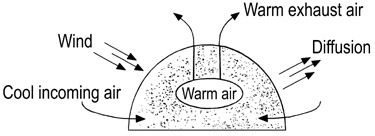
Passive composting or piling (Figure 1) is simply stacking the materials and letting them decompose naturally. This method is simple and low cost but is very slow and may result in objectionable odors.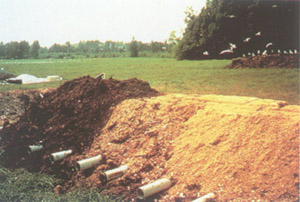
In Aerated static piles air is introduced to the stacked pile via perforated pipes and blowers. This method requires no labor to turn compost but is weather sensitive, and can have unreliable pathogen reduction due to imperfect mixing.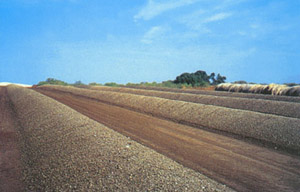
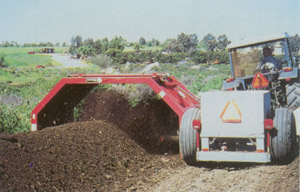
Windrows are long, narrow piles that are turned when required based on temperature and oxygen requirements. This method produces a uniform product and can be remotely located. However, turning the compost can be labor intensive or require expensive equipment. Windrows are typically used for large volumes which can require a lot of space. In addition, windrows can have odor problems, and have leachate concerns if exposed to rainfall.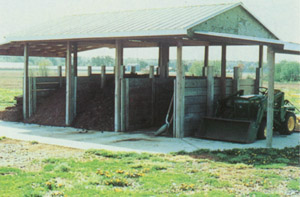
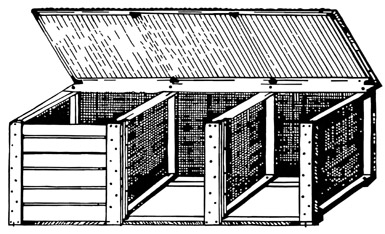
Bins using wire mesh or wooden frames allow good air circulation, are inexpensive, and require little labor. Three chamber bins allow for faster compost production utilizing varying stages of decomposition. Bin composting is typically used for small amounts of food waste.
This three-bin system can handle significant quantities of materials. It also allows staged composting, by using one section for storing compostable materials, one section for active composting, and one section for curing or finished compost. Note: You can use discarded wooden pallets instead of new wood to make a three-bin system.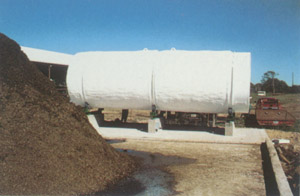
In-vessel systems using perforated barrels, drums, or specially manufactured containers are simple to use, easy to turn, require minimal labor, are not weather sensitive, and can be used in urban and public areas. The initial investment can be high and handling volumes are typically low.
Vermicomposting uses worms to consume the food waste and utilizes its castings as high quality compost. This is usually done in containers, bins, or greenhouses. Typically 1 pound of worms can eat 4 pounds waste per week. Many schools use this type of composting as an environmental education tool. Worm castings bring a premium price but the investment in worm stocking may be high depending on the size of the operation. If too much waste is added anaerobic conditions may occur. In addition, worms cannot process meat products.
What Must I Know to Make and Monitor Food Waste Compost?
Proper nutrient mix, or carbon to nitrogen ratio (C:N) is important for bacteria to process organic material into compost. The optimum ratio to begin composting is 30:1. If the ratio increases decomposition is slowed, if the ratio decreases foul odors and nitrogen loss can occur. Food waste is typically 15:1, fruit waste 35:1, leaves 60:1, bark 100:1, and sawdust 500:1. For example, a recipe using 1 part leaves and 1 part food waste by volume would achieve close to a 30:1 ratio. It may be worthwhile to contact your county agricultural extension agent or the University of Georgia for information on obtaining lab analysis of the feedstocks in your compost mix.
A moisture content of 60 percent is optimal for microorganisms to breakdown the compost. Moisture contents above 70 percentcreate anaerobic conditions, slow down the process and can create foul odors. Moisture below 50 percent also slows down the decomposition process. The moisture content of fresh food waste is 80 to 90 percent, sawdust is 25 percent, and yard waste is 70 percent. Compost with a proper moisture content will form a clump and will slightly wet your hand when squeezed. If the clump drips water, it is too wet and may require additional aeration or more bulking agent. If the compost falls through your fingers, it is too dry and may need water additions or more food waste.
Aeration or oxygen is essential for optimum microorganism populations to effectively breakdown the composting material. This can be done by turning, mixing, the use of blowers, fans, aeration tubes, aeration holes, or raising the compost off the ground.
Particle size can affect the rate of decomposition of compost. The smaller the particles the more aeration the compost receives and microorganisms can break down smaller pieces faster. This can be accomplished by shredding, chipping, chopping, or cutting composted materials before they enter the compost pile.
PH levels from 6.0 to 7.8 are considered high quality compost. Proper C:N ratios should create optimum pH levels. Starting with a fairly neutral pH will ensure high levels of microorganisms for efficient decomposition.
Temperature of the compost is important while biological activity takes place in the decomposition process. Low outside temperature slow down the process, while warmer conditions speed up the process. Mesophillic bacteria function between 50 andf 113 degrees F to begin the composting process. Thermophillic bacteria take over and thrive between 113 to 158 degrees F. These high temperatures are what destroy weed seeds and pathogens in the compost. Some composting manures can reach temperatures of 200 degrees F. However, temperatures above 158 degrees F may char the compost or create conditions suitable for spontaneous combustion.
When Is the Compost Done?
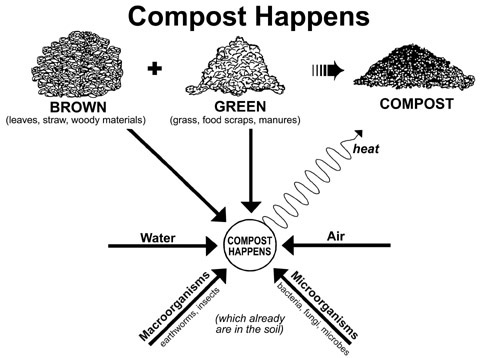
Mature or stable compost is similar to humus in appearance, smell, and touch. The finished compost will no longer heat on its own, thus maintaining the ambient temperature, and there will be no weed seeds or pathogens. The pH will be near 7.0, and the moisture content will be between 35 and 50 percent. The C:N ratio will be 10:1 to 25:1. The organic matter content will be between 40 and 65 percent. It is important to protect the compost from windblown weed seeds until its point of use.
It is very important not to apply unfinished or immature compost, it may have phytotoxins that can kill plants. An inexpensive way to test for mature compost is the watercress test. Watercress seeds will not germinate or grow in immature compost because they are very sensitive to pH and nutrition.
Various Uses, Applications and Markets for Finished Compost
Compost has many uses on the farm. It can be used as a soil amendment to improve soil structure, infiltration rate, water holding capacity, and tilth. It will increase soil microorganism populations, soil organic matter and humus. Compost can also be used as a fertilizer supplement for nitrogen, phosphorous, potassium, and trace elements. Mature compost has no objectionable odor, never “burns” as fertilizers do, can be used to suppress insect pests and soilborne plant pathogens, and act as a fungicide. A major California fruit and vegetable grower was able to cut pesticide use by 80 percent after three years of compost applications as part of an organic matter management system. On composted fields, growers in the San Juaquin valley saved an average of $35 an acre on defoliation costs compared to uncomposted fields.
Compost can be used to increase pasture quality in intensively managed grazing systems. Compost does not decrease palatability of a pasture as raw manure does. This can be very important to farmers who no longer produce row crops where raw manure was generally applied. Convenience is also an advantage of compost, because it is a stable product it can be stored and applied when it fits the farmers schedule and the field does not have to be taken out of production.
Compost can also be used as a mulch for trees, orchards, landscapes, lawns, gardens, and makes an excellent potting mix. Additional uses for compost include vegetable production, field crops, annual forest plantings, sod farms, greenhouse crops, mined lands, roads (city, county, state), and recreation areas (golf courses, trails, athletic fields, and parks). To be commercially viable, supplies of raw materials must be reliable and potential markets for mature compost use must be developed.
Application rates will vary depending on crop nutrient needs, field history, and local climate. Applying 300 pounds of compost per 1,000 square feet, at a depth of 6 inches will increase soil organic matter by 0.5 percent. For row crops recommendations range between 3 and 10 tons per acre, while pastures recommendations go up to 4 tons per acre. Some berry and squash crops recommendations are between 25 and 75 tons per acre. While compost is a slow release of nutrients, reports vary in its ability to meet the nutrient needs of crops. You should have your compost analyzed for its nutrient content and adjust your application rates accordingly. Your county extension agent can help you with this.
The market for compost is one of increasing demand. Supermarkets, restaurants, and schools produce 16 million tons of commercial organic waste that may be composted. Source separated food scrap compost is generally higher in nutrient value and lower in contamination than most other types of compost, thus making it more valuable in the market. Composts from source-separated feedstocks have the highest average revenue per ton at nearly $40. Compost from yard trimmings has a value of $32 a ton and municipal solid waste compost has a value of $3 a ton.
The potential market size of compost in agricultural applications is by far the largest, with silvicultural applications as the second largest.
| Application | Size (million cubic yards/year) in the U.S. |
| Agricultural applications | 895 |
| Silvicultural applications | 104 |
| Sod production | 20 |
| Residential retail | 8 |
| Delivered topsoil | 3.7 |
| Landscapers | 2 |
| Nurseries | 0.9 |
| Landfill cover and surface mine reclamation | 0.6 |
| Source: Resource Recycling Journal |
One of the benefits of food waste composting is the financial savings from landfill tipping fees and the potential financial gain from the sale of the finished product.
| Strategy | Mid-range program cost per ton | Collection and disposal costs saved per ton | Revenues per input ton | Savings per ton |
| Grasscycling | $1 | $38 | $0 | $37 |
| On-site institutional composting | $49 | $61 | $20 | $32 |
| Backyard composting | $13 | $38 | $0 | $25 |
| Yard trimmings composting | $66 | $61 | $16 | $11 |
| Commercial composting | $72 | $61 | $20 | $9 |
| Mixed waste composting | $113 | $102 | $2 | $9 |
| Source: Resource Recycling Journal |
What Is the Future in Composting?
As landfill space and openings decrease, there will undoubtedly be more pressure to compost food waste along iwth all organic waste. As tipping fees increase and it becomes prohibitively more expensive to landfill, composting may be an attractive financial alternative as well as a value-added opportunity. Laws already exist in many states that require counties to compost. Oregon and Washington are developing laws that will require all businesses to compost all of their organic waste including food waste. As agricultural practices continue to exhaust soils and deplete organic matter, compost will be integral in maintaining soil fertility. Landscape, nursery, public agency and homeowner demand for high quality compost continues to increase. Compost is an essential product in increasing amounts of land reclamation projects. Compost also plays an important role in more environmentally regulated and environmentally aware agricultural systems. For many livestock, poultry, and sustainable and alternative agriculture operations, compost and composting may be the best choice as well as opportunity for added income.
For More Information, Contact:
Your county Extension agent at 1-800-ASK-UGA1.
The University of Georgia Environmental Engineering Outreach Group: 706-542-2154.
The University of Georgia Bioconversion Research and Education Center in Athens, Georgia: 706-227-7147.
Related Publications
Barker, J. Formulating an Organic Compost Recipe. Water Quality and Waste Management. North Carolina Cooperative Extension Service. North Carolina State University. www.bae.ncsu.edu/programs/extension/publicat/wqwm/waste.html
Biocycle: Journal of Composting and Recycling. Contact: 610-967-4135.
Dougherty, M. Field Guide to On-Farm Composting. Natural Resource, Agriculture, and Engineering Service. Contact: 607-255-7675.
McLaurin, Wayne J., and Gary L. Wade. 1991. Composting and Mulching: A Guide to Managing Organic Landscape Refuse. (Revised). University of Georgia Cooperative Extension Circular 816. University of Georgia.
Sherman, R. Worm Away Your Cafeteria Food Scraps. Water Quality and Waste Management. North Carolina Cooperative Extension Service. North Carolina State University. www.bae.ncsu.edu/programs/extension/publicat/wqwm/waste.html
U.S. Environmental Protection Agency. Summary of Compost Markets. Contact: 703-487-4650.
U.S. Environmental Protection Agency. Organic Materials Management Strategies. Contact: 800-424-9346. www.epa.gov/osw/; select “Reduce, Reuse, Recycle.”
References
Barker, J. Formulating an Organic Compost Recipe. Water Quality and Waste Management. North Carolina Cooperative Extension Service. North Carolina State University.
Campell, Stu. Let It Rot. Vermont: Story Publishing.
Das, K.C., and E.D. Threadgill. Bioconversion Research and Demonstration at the University of Georgia. Southeastern Sustainable Animal Waste Management Workshop: Proceedings.
Donald, J. Composting Agricultural Wastes in Alabama. Alabama Cooperative Extension Service. Auburn University.
Dougherty, M. Field Guide to On-Farm Composting. Natural Resource, Agriculture, and Engineering Service.
Environmental Protection Agency. Compost: New Applications for an Age-Old Technology.
Environmental Protection Agency. Organic Materials Management Strategies.
Environmental Protection Agency. Summary of Markets for Composts.
Georgia Department of Community Affairs. 1998 Georgia Solid Waste Management Annual Report.
Goodwin, K. Rural Community Yard Waste Composting Systems. Oklahoma Cooperative Extension Service. Oklahoma State University.
McLaurin, W., and Gary Wade. Composting and Mulching. University of Georgia Cooperative Extension Circular 816.
New Holland. Composter Handbook.
Sherman, R. Worm Away Your Cafeteria Food Scraps. Water Quality and Waste Management. North Carolina Cooperative Extension Service. North Carolina State University.
Smith, Wayne. Beneficial Uses of Compost in Florida. Environmentally Sound Agricultural Conference: Proceedings.
